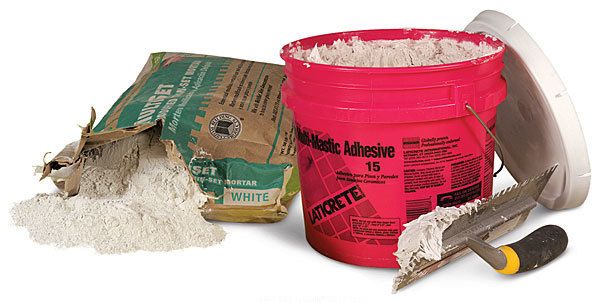
Over the years, I’ve laid tile using both mastic and thinset. Each was around long before I cut my first tile, and each has proved to be a sound material when used appropriately.
Thinset is stronger and more versatile
All thinset is cementitious, which gives it far greater shear and tensile strength than mastic. This quality greatly expands where thinset can and should be used. Because thinset cures as hard and as strong as the cement backerboard it’s often adhered to, it is the best material to use when setting tile in demanding conditions: in steam rooms and on floors, shower walls, and ceilings. It even holds up exceptionally well outdoors.
Thinset isn’t as tacky as mastic, so it’s easier to adjust a tile layout as you go. It also means that tiles can slip and sag more easily, which is always a concern on vertical and ceiling installations.
Cost: $10 per 50-lb bag
Mastic has fewer uses, but it’s easier to work with
Mastic is organic glue mixed with additives that give it body, so it can be troweled and textured like thinset. Unlike thinset, which is mixed on site, mastic is ready to use straight out of the bucket. I use mastic for tile backsplashes and tile wainscot because of its great tack and nonslip qualities. I even use it in hot-tub surrounds if I know it won’t be exposed to a lot of water.
Mastic’s bonding strength can be greatly reduced when exposed to water, and it can also sustain mold growth. Another drawback is that mastic cures by evaporation, so when applied too thickly or on large tiles, the adhesive can take a long time to cure—if it cures at all. Also, mastic should never be used on stone tiles because it can be absorbed into the material and cause surface staining.
Cost: $15 for 1 gal.
Photo by: Krysta S. Doerfler





